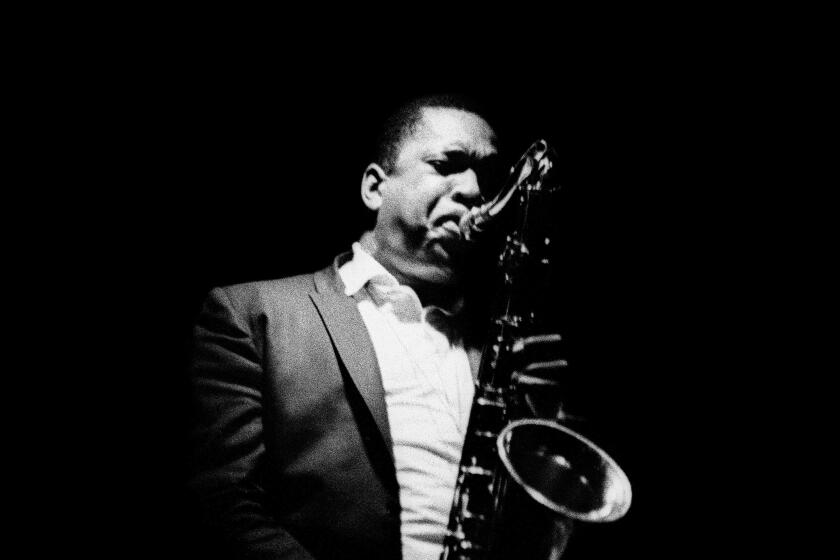Pair of Jazz Players Will Recall Chet Baker, Legend and Friend
- Share via
Trumpeter and singer Chet Baker, who died last May in a mysterious fall from an Amsterdam hotel window, was a tragic hero of mythic proportions, a James Dean of jazz who inspired those around him in profound ways.
San Diego saxophonist Gary Lefebvre and Van Nuys bass player Hersh Hamel are just two of the many musicians whose lives and careers were touched by Baker, a heroin addict never able to kick his obsession.
Both of those old friends will reminisce Sunday night at the Ken Cinema, where “Let’s Get Lost,” film maker Bruce Weber’s sometimes brutal documentary on Baker, has its San Diego premiere.
Weber followed the trumpeter during what turned out to be the last year of his life, and mixed the new material with rare concert footage, interviews with those who knew Baker (including Hamel) and recordings of Baker’s music.
The premiere is a benefit for KSDS-FM (88.3), the San Diego jazz radio station that is hosting the Ken showing.
Along with players such as baritone saxophonist Gerry Mulligan and trumpeter Miles Davis in the early 1950s, Baker forged the sound that came to be known as “Cool Jazz,” a laid-back, melodic counterpoint to the frenzied,
gritty sound of bebop.
Hamel was 19, barely out of high school, when he met Baker at a tiny club in Hermosa Beach in 1949, four years before Baker cut his first records as a leader and soon became an international jazz name. Baker wasn’t into hard drugs yet--he didn’t try heroin until the mid-’50s--and Hamel spent three years close to him, playing clubs, practicing, sometimes just hanging out.
Lefebvre was in his early 20s, searching for a musical direction, when he encountered a much-changed Baker around Christmas, 1965, a “waning star” already well into his addiction. Even so, Baker’s music was still powerful, strong enough to leave a lasting impression on Lefebvre.
“When I met him, he’d just come back from Europe. I was working with Mel Torme at the Crescendo in Los Angeles. Chet came in to hear Mel and liked the way he sang. Their voices have a similar kind of mellow quality. Chet’s lead trumpet player, Al Porcino, introduced me, but I already knew who he was.
“I found out he was living in Manhattan Beach close by where I was living in Redondo. We swapped phone numbers and started practicing at his place. He connected melodic lines with such logic that he didn’t leave any room for questions as to whether or not his playing was good.”
Baker and Lefebvre’s quartet had regular gigs at Shelly’s Mannehole in Los Angeles, and Lefebvre thinks they had a special chemistry. But Dick Bock, Baker’s producer for the Pacific Jazz label, didn’t feel the group had enough commercial potential.
“He was trying to promote Chet with Bud Shank, who had more of a name draw,” Lefebvre said.
Both Hamel and Lefebvre remember Baker as a strong, silent type.
“He didn’t talk a lot, but when he did, he said things that had to be said. He was short on words, long on knowledge,” Lefebvre said. And Baker was a stickler for the smallest details.
“I remember one job I worked with him at the Inter-Continental Hotel in Los Angeles,” Lefebvre said. “He wanted us to wear these little black string ties, all of us in an eight-piece band, dressed alike. When I walked in, he was clear across the room and he waved me over and reached down and adjusted my tie. I asked what he wanted, and he said, ‘That’s all.’ He was a perfectionist.”
That gig was to be a trial run in front of three businessmen who were considering backing Baker in a mariachi band, which they thought had commercial potential. But Baker had other ideas.
“We were supposed to play music that would show them what could be done, but Chet ignored that all night. We had arrangements for the eight-piece band, but Chet just went into Sonny Rollins’ ‘Pent Up House’ and expected me to come in. That was his way of telling them he wasn’t gonna be doing that junk. He was a rebel in a lot of ways.”
By 1968, Baker left for New York. He hadn’t recorded an album in more than three years. Lefebvre went to play in Las Vegas, ever thankful for their time together.
“I was able to lock everything in melodically that I couldn’t lock in before. Being able to play with someone that inspired brought me to my full potential.” Unfortunately, their playing together never made it to vinyl.
Bassist Hamel first heard Baker at a Sunday jam in 1949 in Hermosa Beach.
“He was playing his silver trumpet and French horn, too, which is very unusual. You could hear the music and I looked in,” Hamel said.
“I liked his playing. I introduced myself and sat in on the session. We started talking, and I asked him if he wanted to play, he said, ‘Sure,’ and we arranged to get together. He told me about another session at Esther’s, on the outskirts of Hermosa Beach. I brought Art Pepper there, and Jack Montrose--we were all sort of a little clique.
After a year, Baker and Hamel’s band hadn’t been able to get enough gigs to support them, and Baker and drummer Bob Neel enlisted to play in an Army band in San Francisco, against the advice of their buddy Hamel. Baker was discharged a few months later after going AWOL several times and faking a “psych-out.” Hamel lost track of him until he returned to Los Angeles about 1952 and began to make it, playing with Charlie Parker, eventually recording with Gerry Mulligan in one of his now-famous pianoless quartets.
Hamel said the piano was dropped more by circumstances than musical inspiration.
Mulligan was appearing at The Haig on Wilshire Boulevard and didn’t object when the owner moved out a grand piano to add more tables. With Baker and without piano, Mulligan’s group got rave reviews, and their regular gigs at the small club were soon frequented by Marilyn Monroe, Jane Russell and other Hollywood types. Before long, Mulligan went to jail for marijuana possession, and Baker formed his own band. By the time Mulligan got out a few months later, Baker was a star in his own right.
“He offered Chet a job as a sideman, but Chet turned him down. Gerry was dragged with it.”
Hamel went on to play with Art Pepper and others, but he can still hear Baker.
“What stood out to me was Chet played so beautifully in the low register. He had a big, wide mouthpiece that gave him a mellow, flat sound. He wasn’t interested in playing be-bop riffs or cliches, going along with the trend. He was more interested in playing standards and pretty tunes, yet playing them in a jazz way, improvising, not emulating other people, reaching down within himself for his own inner strength, his own musical self.”
These days, Hamel keeps Baker’s music alive a few times a month with his Chet Baker Tribute Band around Los Angeles.
He’s a fan of “Let’s Get Lost,” having seen it three times, but he has his criticisms.
“I didn’t think there was quite enough music. It has very unflattering photography of Chet in the latter stages of his life. There’s one scene where Chet’s in a hotel room, and a light from across the street comes in the room every now and then and goes right across Chet’s face. It makes him look like Methuselah or something.
“Bruce has a way of capturing him in his most terrible moments. He could just as well have photographed him in a more flattering way, but maybe that isn’t what he was after.”
“Let’s Get Lost” plays through July 8.
More to Read
The biggest entertainment stories
Get our big stories about Hollywood, film, television, music, arts, culture and more right in your inbox as soon as they publish.
You may occasionally receive promotional content from the Los Angeles Times.










